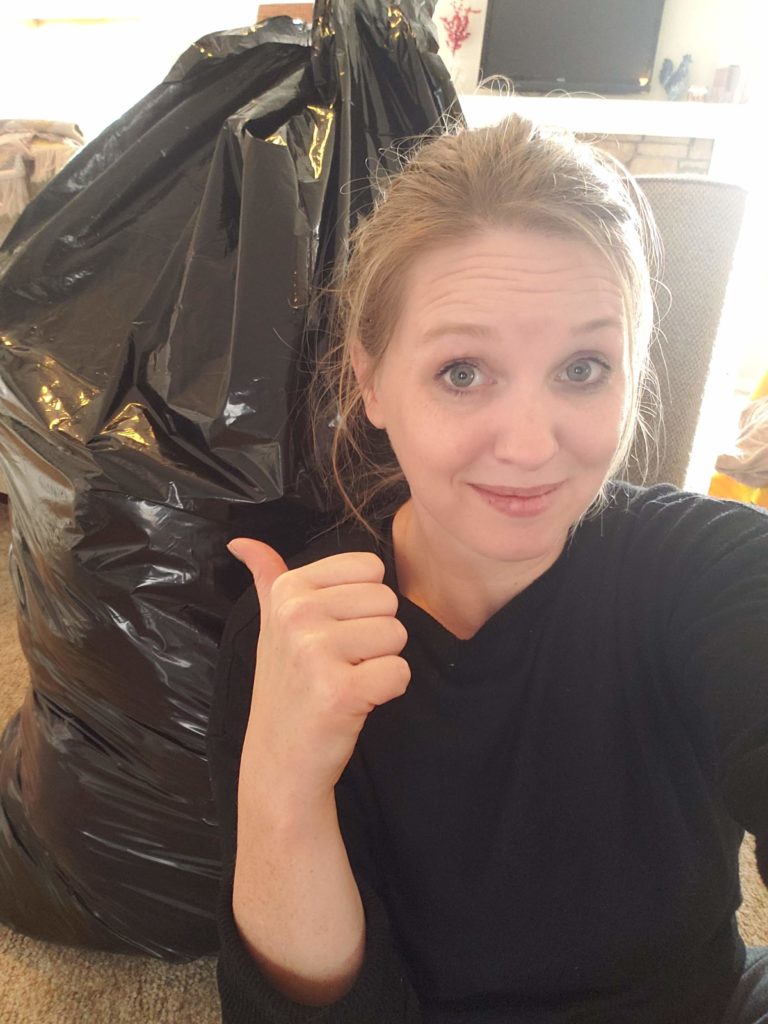Help! My husband won’t declutter.

You’ve finally reached the point that you are craving LESS in your life. Your clutter is leaving you overwhelmed, exhausted, and honestly really ticked off a little annoyed with your family members.
What’s a girl to do if you want simplicity, but you have a spouse that collects, hoards, or otherwise ignores clutter all together? It’s not always an easy process, but I’m going to share some ideas that have worked for me and some of my organizing clients to move the needle in the right direction.
Word Of Warning
Before we get started, I would be remiss not to offer this one piece of advice upfront. Do not, in any case, donate or throw out your spouse’s belonging without a conversation. Doing so will only set this process back and cause mistrust and discord between you.
Whether you are dealing with a spouse or a reluctant kid, patience is your go-to here. I know, not my strong suit either. But, stick with me, and you’ll see why riding this out and gently encouraging are going to be the best path. And I’ll share some tips directly from MY husband that helped him to come along on this journey with me.
The truth is you are not likely going to convince your husband to declutter by pleading, explaining, or convincing. You’ll need to lead by example and use a few tactics to get him on your side.
Start with you
Do you know that bible verse that talks about calling out the speck in someone’s eye when you have a plank in yours? Yeah, it’s not fun to think about it, but if clutter is overwhelming you there’s a good chance it’s everyone’s stuff, including yours.
It’s much easier for us to see other people’s clutter than it is to see our own. This is especially true if you handle the majority of the household chores. If you tend to be the one picking up around the house, you might find yourself mumbling four-letter words under your breath or plotting to have a bonfire that is fueled by all the ‘stuff’ you keep returning to your spouse’s space.
All this frustration is probably causing you to be a little extra annoyed by their stuff. But, since we can’t convince our spouse to clear it out, we need to lead by example and tackle our own spaces first.
Starting with our clothing, craft supplies, excess shoes, or bedside tables helps you to regain control and sanity in the places that affect only you. If you can’t get a team effort, carve out personal pockets of sanity first.

Tackle the “kinda community” spaces
We have spaces in our home that are “his and hers” – think nightstands, closets shelves, bathroom cabinets or drawers, or maybe even home offices. And then we have “family spaces” like the living room, kitchen and dining room that everyone uses.
But, tucked into the nooks and crannies of our homes, we have “kinda community” spaces. These are spaces that house things everyone might use, but are typically maintained and accesses 95% of the time by you. Think linen closets, coat closets, laundry room drawers and cabinets, and possibly the kitchen cabinets too.
These spaces are the best next go-to area to declutter because our spouses likely don’t know or care what’s in them. You’ll know if you found a “kinda community” space if you don’t feel like you need to ask your spouse’s opinion on its contents, and it doesn’t contain items that are specifically his only.
Designated Drop Zone
Having a conversation with your spouse about how clutter is making you feel will be an essential step. We have to remember that not everyone is bothered by clutter, and in fact, a Yale study proved that men do not have the same stress reaction to disorganization that women do. So your husband is probably not affected by the piles of papers and shoes that gather at your door.
Being armed with this piece of information may lead you to have a conversation that sounds something like this. “I know the clutter in our home is not very bothersome to you, and that’s okay, but it’s important to me that you understand that it is very bothersome to me. It makes me feel (overwhelmed, angry, anxious), and I need help to keep our main living spaces clear of it.”
From here, talking about a “designated drop zone” for his excess stuff can help to curb your anxiety about the clutter. A client of mine keeps two drawers for her husband and son so they can ‘store’ their clutter. When she is picking stuff up from around the house, it goes into the drawer. They avoid the “have you seen my” conversation because the guys know exactly where to look. When the drawer gets too full, she asks them to clean it out.
My husband’s home office, which is out of sight, collects legos, and work items. He isn’t bothered by what I would feel claustrophobic in, and so I avoid this space, and he has the flexibility to store what he wishes.
Let’s Try And See
Honestly, this idea was the most helpful of any other when we began to tackle those communal spaces in our home. When I wanted to cut our dishes in half, toss half the cooking utensils and small appliances, my husband looked at me like I had lost my mind. I said these six words: “Let’s just try it and see”.
We stored the items in bins along the wall in the dining room, and I offered that anything he went looking for could stay. After two weeks, anything we didn’t reach for we donated. At the two week mark he said to me “I guess we can get rid of all that stuff, I didn’t need anything”. The funny part was, I had already donated it two days prior, and he never missed it.
Years into this journey, and we have yet to miss an item that we’ve tossed or donated.
Out Of Sight
The “out of sight” method piggybacks on the “try and see” process beautifully. Whether it is you or a spouse that isn’t sure how getting rid of something might go, packing it up and placing it out of sight for a while can be a great indicator of its necessity. Not sure you want to ditch those dress pants? Pack them up. Not sure you won’t miss that home décor item, electronic or appliance? Put it out of sight and out of mind for an agreed-upon time. If no one goes looking for it, ask for a truce and agreement to get rid of it.
Remember the Goal
At its heart, the purpose behind simplifying is to bring happiness and joy back into your home and your relationships. I promise it will most certainly do that. With less stuff to care for, you will have more time to care for yourself and each other. You’ll find white space and quiet time to relax or explore, and this simple change will probably lead your family to follow your suite.

Don’t let the struggle over stuff pull you apart. It took years for your home to amass the clutter and possessions that it now houses, and though decluttering can immediately relieve that feeling of being suffocated, small changes can yield significant results. When you reclaim your personal spaces and find common ground in the shared ones, you will find that the extra clutter won’t bother you quite so much. Be patient. Offer grace and know this is a process that each person has to find on their own.